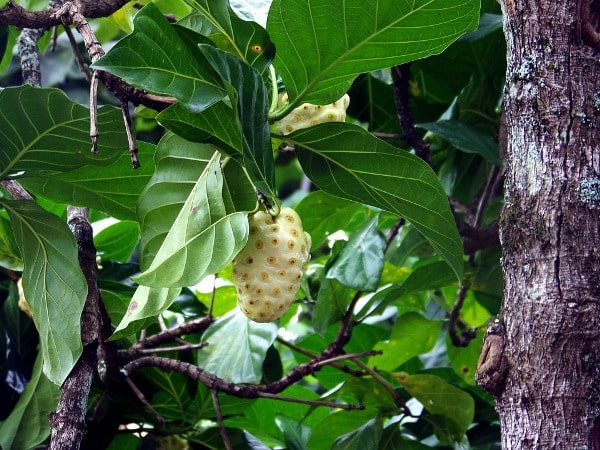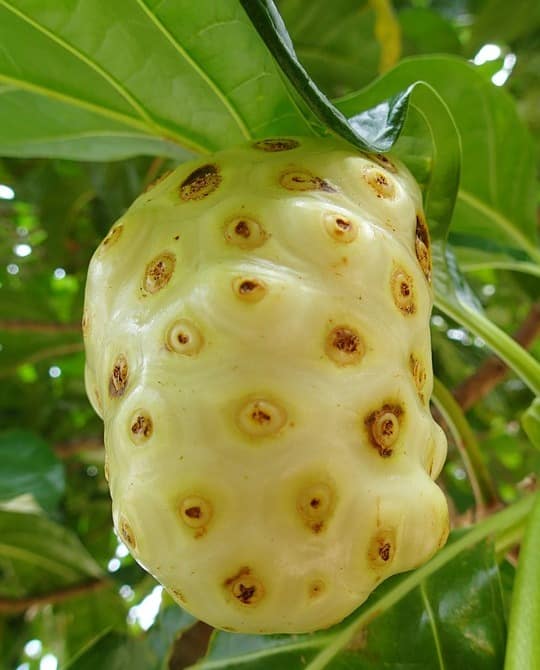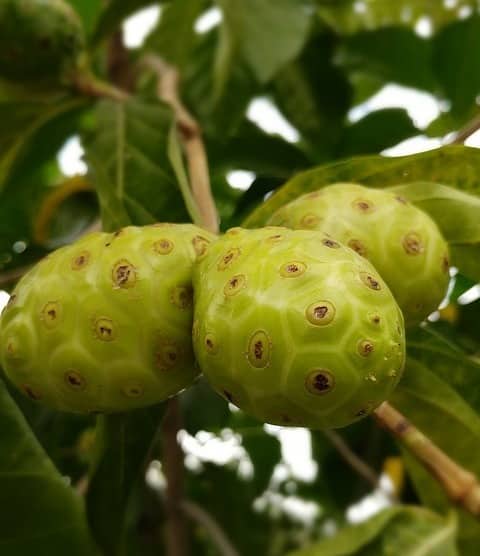Introduction to growing Noni Fruit
Many people are asking about Growing Noni Fruit, hence the following information is provided.
Noni is one of nutritious fruit that is widely grown for its health restorative properties, the main disadvantage with this fruit is its unpleasant smell of the ripened fruit. It is a tropical fruit commonly called as Indian Mulberry.
Noni grows into a small tree, that grows up to 3 to 6 meters high, which stay green throughout the year. The stems of the trees are erect, slender, gnarled, gray or brown. This shrub needs the support of other trees like a Vined plant. The Leaves of the plant are glabrous, opposite, petiolate, glabrous oblong-round shape, with well-marked nervousness. Stipules paired at the leaf base. Flowers of Noni plant are in white color with 4 to 6 lobes. The fruits are fleshy syncope type or some in medium-sized, ovoid in pale green color with an elliptical shape and with an unpleasant smell.
Soil and climate requirements for Growing Noni Fruit

Noni grows in a very wide range of soils and environment and it has the ability to survive in harsh environments. Noni tolerates can tolerate a wide range of drainage conditions, including seasonal waterlogging, but it thrives well in fertile well-drained soils. It can grow in soil in a wide range of pH levels. Mature cultivated Noni can resist the temperature from 20-35 °C and with an annual rainfall of 250-4000 mm.
Propagating Noni Fruits for Growing Noni Fruit
Noni fruit plants can be propagated either from seed or stem cuttings. The main disadvantage of seed propagation is that without providing seed treatment and applied heat, the chances of seed germination may be unreliable and seedling development may take 6–12 months for germination and 9–12 more months to get ready for transplantation. While propagating the Noni from stem cuttings takes less time, it can be rooted in about 2 months and be ready for transplanting within 4–6 months. But the disadvantage with propagating the plants from cuttings is that they may not be as strong and disease-resistant as seedlings, and the trunk and branches may split and break during the first years of fruit production.
Propagation of Growing Noni Fruit
Propagating Noni plants from seeds:
Noni plants are propagated from seeds, stem or root cuttings and air layering. The preferred methods of propagating are from seed and by cuttings made from the stem. Noni plants produce flowers and fruits around the year. Fruits are collected from plants have large fruit, vigorous leaf growth for hedges, etc.
Noni seeds are in reddish-brown, oblong-triangular, and have a conspicuous air chamber. The Noni fruit seeds are buoyant and hydrophobic, water repellant, fibrous seed coat. The seed coat of Noni fruit is very tough, relatively thick, and covered with cellophane-like parchment layers. A single large Noni fruit can have 100 – 150 seeds. For seed propagation use Noni fruits should be chosen for seed collection. The seeds are collected from fibrous, clinging fruit flesh.
Treating Noni Seeds for Growing Noni Fruit:
For seed collection, split the fruit into smaller pieces. Separate the seeds from the flesh by cleaning with water and washing the pulp through the screen while retaining the cleaned seeds. Scarifying the hard seed coat by nicking or puncturing which reduces germination time, improves germination rate and promotes uniform sprouting. Basically, the seed coat must gradually decompose before water can enter, scarification overcomes this natural seed dormancy.
You can also use a household blender to separate seeds from the fruit and can also result in nicking the seed coats.
Noni seeds can be dried and stored for a long period. After cleaning, dry the seeds in the shade or indoors for 2 or 3 days. Now store the seeds in an airtight container at room temperature.
Fresh Noni seeds can be planted immediately as soon as you extract from the fruit. Some cultivators soak the seeds till they start to germinate, after germination, plant them in containers, while others plant fresh seeds without presoaking treatment.
Noni seeds require hot, wet conditions for optimum germination of seeds. Untreated seeds take more than a year before natural germination takes place, but this period can be reduced to a month or so using heat. The Noni seeds can tolerate a temperature of 38°C to 45°C. Choose the warmest location in the nursery or greenhouse for Noni seed germination. You can supply heat to seeds, using nursery heating pads under the seed flats, or by placing the flats or containers in a special “hoop house” covered with clear plastic. If the seeds are germinated outdoors, place them in the partial sun than the full sun to avoid excessive drying of the medium. Noni seeds can be germinated in seedling bed or trays or sown directly in containers.
A light growing medium that retains water yet remains aerated is best. Some suitable growing medium should be a combination of vermiculite, perlite, peat moss, commercial potting media, compost, and fine volcanic cinder. For seedling flats, use a light growing medium, the best growing medium can be, one part each of perlite and peat moss, or perlite, vermiculite, and potting soil in a 2:1:1 ratio.
For growing Noni in containers, use a slightly heavier growing medium, such as one part of perlite or vermiculite and three parts of a potting mix.
Don’t mix any fertilizers into the medium, as the plant doesn’t need any additional nutrients till the plants have their first true leaves. Commercial potting soil is highly recommended for germinating and growing out Noni seedlings. The Commercial potting soil is sterile and gives plants a clean start.
When seeds are germinated on the flats, they should be transplanted into growing containers within a few weeks of germinating. The size of the plant depends to a large extent on the size of pot used—the larger and deeper the pot, the larger and more vigorous the Noni seedling. The pots, which can hold 2 to 3 gallons of soil are good enough for rooting volume to produce large, healthy seedlings for transplanting. Noni plants can become pot bound and stop growing if the pots are too small or shallow or they are grown for more than 9–12 months.
The Noni plants grow vigorously, with a strong root system that can be easily recovered from being pot-bound once transplanted into suitable field conditions. Noni seedlings are grown in pots in the full sun for a minimum of 9–12 months before they are transplanted to the field. Seedlings of Noni plants grow up to 3 years old or more may also be planted. If Noni plants are transplanted too young, they are more susceptible to weed, mechanical damage, and slug attack. Seedlings and young plants are grown from cuttings should be fed with liquid fertilizer once a month, or a controlled-release fertilizer, less often. Balanced formulations such as 14-14-14 that also contain micronutrients are recommended. Young plants grow faster when we apply dilute, liquid foliar fertilizers. As plants become established, granular, rapidly soluble formulations are recommended. Noni plants are salt-tolerant, and fertilizer burn is uncommon under normal conditions.
Read: Growing Pearl Millet.
Vegetative propagation of Growing Noni Fruit:
If propagating the Noni plants from stem cuttings, it takes very less time for the plants that are ready for transplanting. Cuttings from the stems and branches will sprout roots when provided with proper growing conditions. Select vigorous plants for propagation. Remove a branch or stem and make sure that the fresh sap flow from the wound. If sap does not flow from the cut end, discard the material and select another plant, another location, or perhaps wait for a better time of year. Sap flow indicates an actively growing plant.
The stem cuttings of different sized can be used for propagating Noni. But the ideal size of cutting should be 20-40 cm (8-16 in) cutting that is easily manageable and effective. Stem cuttings take 3-4 weeks and are ready for transplanting in 6-9 weeks.
Insert the cutting of Noni stems into a pot containing a general-purpose growth medium. As with seed germination, heat at the bottom will enhance the rooting system, and an artificial, pathogen free medium refers to the untreated agricultural field soil. Select a location with partial shade and keep the cuttings well-watered until rooting occurs. After rooting, move the containers in full sun and begin fertilizer applications.
The Best Season for Growing Noni Fruits

Noni fruit plants produce more fruits in summer than in winter. However, Noni produces new leaves and fruits around the year wherever it is grown.
Suitable Soil for Growing Noni Fruit
The soil should be free from weeds and nematodes and the soil should be mixed with sand, composted organic matter is excellent for seed germination. The soil affected with Nematodes should be avoided or it should be treated with heat. The Mulch like sawdust, leaf litter or sand, should be applied over the seeds for weed control and moisture retention.
The germination rate seed is high in conditions ranging from deep shade to full sun. The best seed germination can be achieved in light partial shade (20-30%). After the germination, in early growing phases the plant needs partial shade (20-30%).
Transplanting method in Growing Noni Fruit
Noni seedlings should be transplanted after 2-12 months after germination. After transplanting, the first year of seedling growth will be slow due to transplant shock and the establishment of a root system. Later, seedling growth is much higher as the crown gains, size, and photosynthetic mass.
Plant Protection or care in Growing Noni Fruit
The Noni plants are susceptible to a wide range of insects, such as aphids (e.g., the melon aphid, Aphis gosypii), scales, weevils, leaf miners, whiteflies, thrips, and spider mites.
High usage of fertilizers can attract sap-feeding insects like aphids, whiteflies, scales, that cause a buildup of sooty mold on Noni leaves. Sucking insects can be controlled by spraying of 0rganic pesticides twice a year and caterpillars by contact pesticides.
In high rainfall regions and flood areas, Noni plants are highly affected to certain plant diseases caused by fungi or fungus-like organisms: leaf spots, stem and leaf, and fruit blights. These diseases can be minimized by picking up or removing severely diseased leaves and by periodic application of approved fungicides. Copper-based fungicides are highly recommended. The most common and severe pest problem for Noni is root-knot diseases caused by a root-knot nematode, implementing better irrigation techniques like Drip Irrigation System, and applying fertilizer and composts can minimize damage caused by root-knot nematodes.
Using Organic practices like Neem-based formulations; fish oil, resin soap can protect the plants from sucking pests. Use organic extracts of garlic, Vitex negundo, Lantana camera, Clerodendron inerme, Calotropis gigantea should be sprayed periodically for controlling the pests.
Windbreaks:
Young Noni transplants cannot tolerate winds are strong. If the site you are growing is too windy, windbreaks should be planted for protection. Trees such as eucalyptus, ironwood, or wili-wili in rows are excellent windbreaks for Noni.
Plant spacing for Growing Noni Fruit
A Noni crop requires appropriate inter-plant spacing of about 10–15 feet. The at12-foot spacing you can plant 290 plants per acre. Low inter-plant distances will result in plant crowding and may increase pest and disease problems.
Pruning process in Growing Noni Fruit
Pruning should be done regularly, Young plants of age less than 3 years old should be pruned constantly the first production of fruit. In the next growing phrases, the pruned plants will become bushy. Because Noni trees can reach a height of approximately 20 feet, growers may wish to prune the vertical branches of mature plants to facilitate picking. Pruning is effective to control pest and disease.
Nutrition and fertilizer application in Growing Noni Fruit
The quantity of nutrients and fertilizer applications depends Noni depends on the soil and rainfall. Noni trees growing in forests grow healthy without the benefit of fertilizer. Generally, Noni crops require small amounts of applied fertilizer to grow healthy. For intensive fruit production, it needs suitable agricultural setting, a fertilizing program is highly recommended. The frequent fertilizer application will make Noni crop to do best. Young, non-fruiting Noni plants are encouraged to produce lush vegetative growth with balanced fertilizers with N:P: K ratio 14-14-14or 16-16-16, this fastens the maturity or flowering period of the plants and encourages to produce many large fruits by applying high-phosphorous fertilizers such as 10-20-20 or 10-45-10. Young seedlings and transplants are applied with controlled-release fertilizer formulations, while older, mature plants can be fed with granular formulations. Fertilizer should be applied at the “drip line” of the plant, the area where water drips from the edge of the leaf canopy. Noni plants respond well to sprays of foliar fertilizer.
Noni flowers and fruit production will be high with sprays of high-phosphorous foliar fertilizers containing nitrogen and minor elements. Noni should be fertilized with smaller amounts of fertilizer, rather than infrequently using larger amounts.
In areas with high-rainfall, young plants up to a year old should be applied with 1 ⁄2 pound balanced fertilizer (14-14-14) per month, and more mature plants should be applied with 1 pound per month. Crushed coral, dolomite, K-mag, 7-7-7, and composted chicken manure and macadamia nut husks are the best organic fertilizers for Noni crops.
In some regions, applications of lime, about 1 pound per plant will improve the fruit growth. Noni grows well with moderate irrigation requirement and can survive in extended drought conditions.
Harvest Procedure and Yield in Growing Noni Fruit:

Noni fruits can be harvested when they start to turn white, or when they turn soft, translucent and characteristically odorous this indicates that the fruit is fully ripened.
Harvesting period of about three to four years and the regular yield will be from 5th year onwards. The Annual fruit yield will depend on the Noni varieties or genotypes and on the environment (soil, water) and cultivation system and /or ecosystem.
Annual yields of the cup to approximately 80,000 kg/ha or more may be realized with large-fruited genotypes grown in monoculture full sun, with heavy fertilization. Yields depend upon many factors, like soil fertility, environment, genotype, and planting density.
Uses of Noni Fruit:
There are many benefits with Noni fruit, it helps in reducing high blood pressure and cures heart disease and stroke. The substance called Scopoletin in Noni fruit will dilute in the blood vessels resulting in lower blood pressure. It has the ability to stimulate the body’s production of Nitric oxide, a chemical which allows the blood vessel to dilate more easily and be more elastic. Xeronine system in Noni can promote healthy functioning of the circulatory system. Scopoletin has an anti-inflammatory and histamine inhibiting effects for the promotion of smooth joint movement.
The cellular enhancing qualities in Noni will minimize the damage to the joints and other involved tissues. It also enhances the functioning of the pancreas and the immune system.

Hi! Im looking for NONI FRUIT supplier in the Philippines. Thank you.